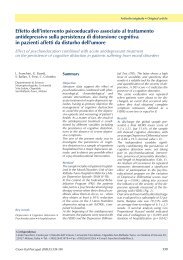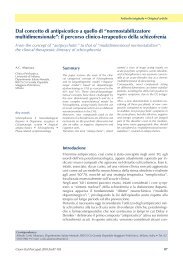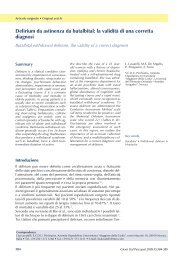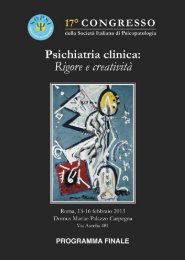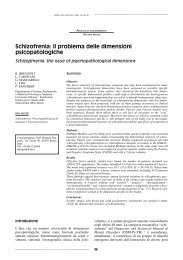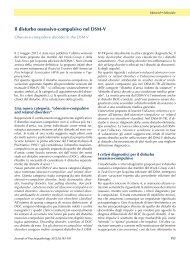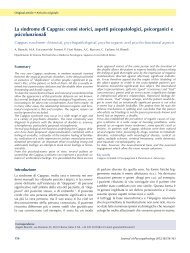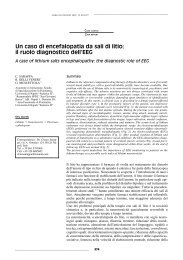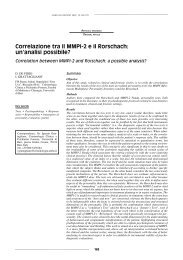XI Congresso della Società Italiana di Psicopatologia Psichiatria ...
XI Congresso della Società Italiana di Psicopatologia Psichiatria ...
XI Congresso della Società Italiana di Psicopatologia Psichiatria ...
Create successful ePaper yourself
Turn your PDF publications into a flip-book with our unique Google optimized e-Paper software.
SIMPOSI TEMATICI<br />
Methods: subjects with MDD confirmed by a SCID were<br />
entered into the stu<strong>di</strong>es after completing an informed consent<br />
process. All subjects were me<strong>di</strong>cation free for a period of at<br />
least two-weeks prior to initial MRS stu<strong>di</strong>es. Proton (1H)-<br />
MRS stu<strong>di</strong>es were performed accor<strong>di</strong>ng to the methods described<br />
by Rothman et al. 1 and Carbon (13C)-MRS stu<strong>di</strong>es<br />
were performed accor<strong>di</strong>ng to the methods described by 2 on<br />
2.1 T and 4.0 T systems. Effects of treatment were determined<br />
by repeated MRS stu<strong>di</strong>es after a period treatment.<br />
Results: occipital cortex GABA concentrations were significantly<br />
decreased and glu concentrations were increased in the<br />
brains of depressed subjects 3 . The <strong>di</strong>fferences appear most<br />
dramatic and consistent in subjects with MDD having melancholic<br />
and psychotic features. Preliminary stu<strong>di</strong>es using 13C-<br />
MRS methods suggest that the altered GABA and glu levels<br />
in MDD are associated with decreased rates of GABA synthesis<br />
and glutamate/glutamine cycling. Furthermore, the<br />
concentrations of GABA appear normalized following treatment<br />
with ECT 4 and SSRI me<strong>di</strong>cations 5 , but not following<br />
treatment with cognitive behavioural therapy (CBT) 6 .<br />
Conclusions: this series of stu<strong>di</strong>es suggest that abnormalities<br />
in amino acid neurotransmitter systems are found in the<br />
brains of a subset of in<strong>di</strong>viduals with MDD. Preliminary data<br />
point toward altered rates of metabolism that may be related<br />
to deficits in glial cell function. Interestingly, treatment<br />
with either ECT or SSRI me<strong>di</strong>cations normalized the<br />
measures but treatment with CBT <strong>di</strong>d not. Thereby, the fin<strong>di</strong>ngs<br />
suggest that the altered function of these systems may<br />
be tied to the basic pathophysiology of the <strong>di</strong>sorder and potentially<br />
the mechanism of antidepressant action for specific<br />
treatment modalities.<br />
References<br />
1 Rothman DL. Localized 1H NMR measurements of γ-aminobutyric<br />
acid in human brain in vivo. PNAS USA 1993;90:5662-6.<br />
2 Shen J. Determination of the rate of the glutamate/glutamine cycle<br />
in the human brain by in vivo 13C NMR. PNAS USA<br />
1999;96:8235-40.<br />
3 Sanacora G. Subtype-specific alterations of GABA and glutamate<br />
in major depression. Arch Gen Psych 2004;61:705-13.<br />
4 Sanacora G. Increased occipital cortex GABA concentrations<br />
following electroconvulsive therapy in depressed patients. Am J<br />
Psych 2003;160:577-9.<br />
5 Sanacora G. Increased occipital cortex GABA concentrations in<br />
depressed patients after therapy with selective serotonin reuptake<br />
inhibitors. Am J Psych 2002;159:663-5.<br />
6 Sanacora G. Cortical gamma-Aminobutyric Acid Concentrations<br />
in Depressed Patients Receiving Cognitive Behavioral<br />
Therapy. Biol Psychiatry 2005;31.<br />
Stabilizzazione del rilascio <strong>di</strong> glutammato:<br />
un pathway presinaptico per l’azione<br />
degli antidepressivi<br />
G. Bonanno, R. Giambelli * , L. Raiteri * , E. Tiraboschi,<br />
S. Zappettini * , L. Musazzi, V. Barbiero, M. Raiteri * ,<br />
G. Racagni, M. Popoli<br />
Centro <strong>di</strong> Neurofarmacologia, Dipartimento <strong>di</strong> Scienze Farmacologiche,<br />
Università <strong>di</strong> Milano; * Dipartimento <strong>di</strong> Me<strong>di</strong>cina<br />
Sperimentale, Sezione <strong>di</strong> Farmacologia e Tossicologia,<br />
Università <strong>di</strong> Genova<br />
I meccanismi <strong>di</strong> plasticità delle sinapsi glutammatergiche so-<br />
no stati implicati nella fisiopatologia dei <strong>di</strong>sturbi dell’umore<br />
e nell’azione dei farmaci antidepressivi. Vi sono numerosi dati<br />
in letteratura che suggeriscono un aumento <strong>della</strong> neurotrasmissione<br />
del glutammato in alcune aree corticali e limbiche.<br />
In uno stu<strong>di</strong>o preclinico abbiamo esaminato gli effetti del trattamento<br />
cronico con antidepressivi sul rilascio <strong>di</strong> glutammato<br />
e GABA evocato da KCl e ionomicina da terminali sinaptici<br />
ippocampali. I trattamenti (10 mg/kg/giorno, per 14 giorni)<br />
con reboxetina (inibitore selettivo <strong>della</strong> ricaptazione <strong>di</strong> noradrenalina),<br />
fluoxetina (inibitore selettivo <strong>della</strong> ricaptazione<br />
<strong>di</strong> serotonina) e desipramina (un antidepressivo triciclico), sono<br />
stati effettuati con minipompe sottocutanee. Negli animali<br />
trattati con tutti e tre i farmaci è stata osservata una significativa<br />
riduzione (25-50%) del rilascio <strong>di</strong> glutammato evocato<br />
da K + , mentre il trattamento acuto con gli stessi farmaci<br />
non ha prodotto alterazioni significative 1 . Abbiamo inoltre<br />
analizzato i meccanismi molecolari presinaptici che regolano<br />
il rilascio evocato <strong>di</strong> glutammato nei terminali sinaptici isolati<br />
(sinaptosomi) e nelle membrane sinaptiche dell’ippocampo.<br />
Negli animali trattati con tutti i <strong>di</strong>versi farmaci alcune interazioni<br />
molecolari chiave nel meccanismo <strong>di</strong> rilascio sono risultate<br />
mo<strong>di</strong>ficate, con modalità che spiega la riduzione del<br />
rilascio <strong>di</strong> glutammato. In particolare il legame tra α-CaM kinasi<br />
II e sintaxina-1, uno dei componenti del complesso<br />
SNARE che regola il rilascio <strong>di</strong> neurotrasmettitori, è downregolato.<br />
Inoltre il legame tra sintaxina-1 e Munc18 (una proteina<br />
presinaptica che blocca la partecipazione <strong>di</strong> sintaxina-1<br />
al complesso SNARE) è up-regolato 1 . Le mo<strong>di</strong>ficazioni sono<br />
dovute ad cambiamento dello stato <strong>di</strong> fosforilazione basale <strong>di</strong><br />
α-CaM kinasi II nelle membrane sinaptiche, indotto dagli antidepressivi.<br />
Questi risultati <strong>di</strong>mostrano che farmaci antidepressivi<br />
con un <strong>di</strong>verso meccanismo d’azione primario agiscono<br />
stabilizzando la trasmissione glutammatergica, e suggeriscono<br />
che questo effetto sia una componente del meccanismo<br />
terapeutico. Inoltre i risultati suggeriscono che i meccanismi<br />
molecolari <strong>di</strong> controllo del rilascio <strong>di</strong> glutammato<br />
siano un potenziale bersaglio terapeutico, utile per la sperimentazione<br />
e validazione <strong>di</strong> nuovi farmaci antidepressivi.<br />
Bibliografia<br />
1 Bonanno G, Giambelli R, Raiteri L, Tiraboschi E, Zappettini S,<br />
Musazzi L, et al. Chronic antidepressants reduce depolarization-evoked<br />
glutamate release and protein interactions favoring<br />
formation of SNARE complex in hippocampus. J Neurosci<br />
2005;25:3270-9.<br />
(Poli)farmacoterapia delle psicosi;<br />
dalla controversia clinica alle evidenze<br />
precliniche: ruolo delle proteine <strong>della</strong><br />
densità postinaptica glutammatergica<br />
A. de Bartolomeis, F. Iasevoli<br />
Laboratorio <strong>di</strong> <strong>Psichiatria</strong> Molecolare e Psicofarmacoterapia,<br />
Dipartimento <strong>di</strong> Neuroscienze, Università <strong>di</strong> Napoli<br />
“Federico II”<br />
1. Evidenze cliniche ed epidemiologiche in<strong>di</strong>cano un significativo<br />
uso concomitante <strong>di</strong> multipli agenti farmacologici<br />
nella terapia delle psicosi e segnatamente nella<br />
Schizofrenia.<br />
2. Particolarmente elevato sarebbe l’utilizzo <strong>di</strong> polifarmacoterapia<br />
(ad esempio due antipsicotici o antipsicotico + sta-<br />
152




